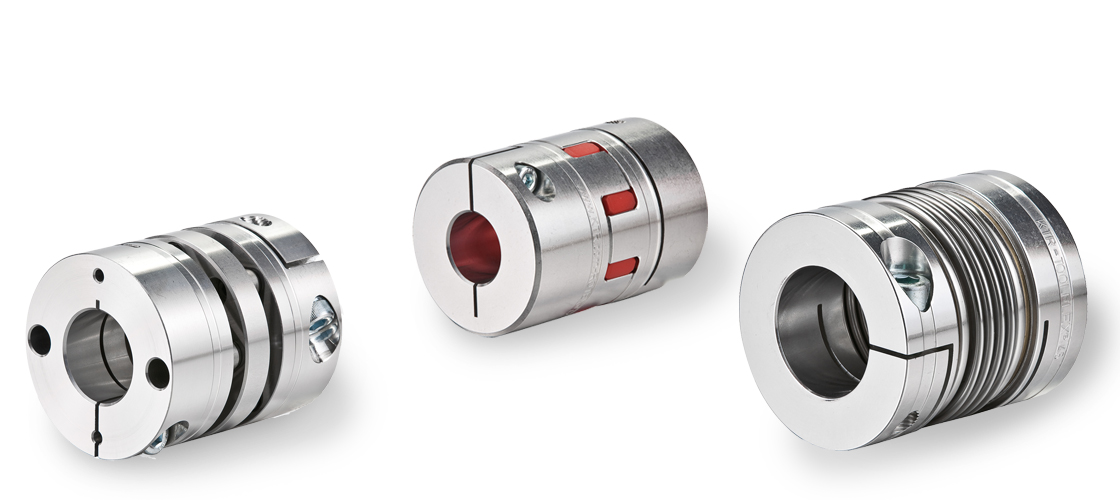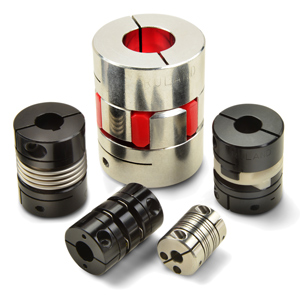Product Description
GR Clamp Rigid Coupling Motor Coupler Servo Shaft Coupling
Description of GR Clamp Rigid Coupling Motor Coupler Servo Shaft Coupling
>The material is aluminum alloy, and the middle bellows is made of stainless steel with excellent corrosion resistance
>Laser welding is used between bellows and shaft sleeve, with zero rotation clearance, suitable for CHINAMFG and reverse rotation
>Bellows structure can effectively compensate radial, angular and axial deviation
>Designed for servo motor stepper motor
>Fastening method of setscrew
Catalogue of GR Clamp Rigid Coupling Motor Coupler Servo Shaft Coupling
|
model parameter |
common bore diameter d1,d2 |
ΦD |
L |
LI |
L2 |
L3 |
N |
F |
tightening screw torque |
|
GR-16×27 |
4,5,6,6.35,7,8 |
16 |
27 |
7.5 |
2 |
8 |
13.5 |
3 |
0.7 |
|
GR-20×32 |
5,6,6.35,7,8,9,9.525,10,11,12 |
20 |
32 |
7.2 |
2.8 |
12 |
18 |
3.5 |
0.7 |
|
GR-22.5×34 |
5,6,6.35,7,8,9,9.525,10,11,12 |
22.5 |
34 |
8.05 |
2.8 |
12.3 |
20.2 |
4.5 |
1.7 |
|
GR-25×37 |
6,6.35,7,8,9,9.525,10,11,12 |
25 |
37 |
9.5 |
3 |
12 |
20.2 |
4.5 |
1.7 |
|
GR-32×42 |
8,9,10,11,12,12.7,14,15 |
32 |
42 |
8 |
4 |
18 |
27.2 |
5.5 |
4 |
|
GR-40×51 |
8,9,9.525,10,11,12,12.7,14,15,16,17,18,19,20 |
40 |
51 |
9.5 |
6 |
20 |
34.5 |
5.5 |
4 |
|
GR-55×57 |
10,11,12,12.7,14,15,16,17,18,19,20,22,24,25 |
55 |
57 |
9 |
6 |
27 |
51.9 |
6.25 |
7 |
|
GR-65×81 |
10,11,12,12.7,14,15,16,17,18,19,20,22,24,25,28,30,32,35,38 |
65 |
81 |
19.5 |
7 |
28 |
60.5 |
8.9 |
7 |
|
model parameter |
Rated torque(N.m) |
allowable eccentricity (mm) |
allowable deflection angle (°) |
allowable axial deviation (mm) |
maximum speed (rpm) |
static torsional stiffness (N.M/rad) |
weight (g) |
|
GR-16×27 |
0.8 |
0.1 |
2 |
-0.8 |
20000 |
150 |
8 |
|
GR-20×32 |
1.5 |
0.1 |
2 |
-1.2 |
18000 |
220 |
13 |
|
GR-22.5×34 |
1.8 |
0.15 |
2 |
-1.2 |
16000 |
300 |
22 |
|
GR-25×37 |
2 |
0.15 |
2 |
-1.2 |
15000 |
330 |
30 |
|
GR-32×42 |
2.5 |
0.2 |
2 |
-1.7 |
11000 |
490 |
53 |
|
GR-40×51 |
6.4 |
0.3 |
2 |
-1.7 |
10000 |
530 |
85 |
|
GR-55×57 |
12 |
0.3 |
2 |
-1.7 |
9000 |
860 |
170 |
|
GR-65×81 |
18 |
0.2 |
2 |
-1.8 |
4500 |
900 |
280 |
/* March 10, 2571 17:59:20 */!function(){function s(e,r){var a,o={};try{e&&e.split(“,”).forEach(function(e,t){e&&(a=e.match(/(.*?):(.*)$/))&&1

Contributing to Accuracy and Repeatability in Motion Systems
Servo couplings play a crucial role in improving the accuracy and repeatability of motion systems by addressing several key factors that influence performance:
- Flexibility and Misalignment Compensation: Servo couplings are designed to be flexible, allowing them to accommodate small misalignments between the motor and the driven load. This flexibility helps prevent mechanical binding and reduces stress on the motor and bearings, ensuring smoother and more accurate motion.
- Backlash Minimization: Backlash is the play or clearance between the mating teeth or elements of a coupling. It can introduce errors in motion systems, leading to inaccuracies and reduced repeatability. Servo couplings, especially zero-backlash types, are engineered to minimize or eliminate backlash, providing precise and immediate response to changes in direction and velocity.
- Inertia Reduction: Inertia refers to the resistance of an object to changes in its state of motion. Servo couplings with low mass and compact designs contribute to reducing the overall inertia in the system. Lower inertia allows for faster acceleration and deceleration, improving the system’s responsiveness and accuracy.
- High Torque Transmission: Servo couplings are capable of transmitting high torque efficiently, ensuring that the motion system can handle the required loads without slippage or power loss. This high torque capacity is vital for maintaining accuracy in high-power applications.
- Vibration Damping: Vibrations can negatively impact the accuracy and repeatability of motion systems. Servo couplings with damping properties can absorb and dampen vibrations, preventing resonance and oscillations that could affect precision.
- Consistent Performance: Servo couplings are manufactured to strict tolerances, ensuring uniformity and consistency in their performance. This uniformity contributes to reliable and repeatable motion control, critical in applications requiring precise positioning and motion.
By addressing these factors, servo couplings enable motion systems to achieve higher levels of accuracy and repeatability, making them suitable for applications such as CNC machining, robotics, semiconductor manufacturing, medical devices, and more. The improved precision and reliability provided by servo couplings lead to higher product quality, increased productivity, and reduced downtime in various industrial processes.

Maintenance Practices to Prolong the Life of Servo Couplings
Regular maintenance is essential to ensure the longevity and optimal performance of servo couplings. Here are some maintenance practices that should be followed:
- Visual Inspection: Perform periodic visual inspections of the servo coupling to check for signs of wear, damage, or misalignment. Look for cracks, corrosion, or any other abnormalities that may affect the coupling’s performance.
- Lubrication: If the servo coupling requires lubrication, follow the manufacturer’s recommendations for the appropriate lubricant type and interval. Proper lubrication helps reduce friction, wear, and heat generation, extending the coupling’s lifespan.
- Torque Checks: Periodically check the torque of the coupling fasteners to ensure they are properly tightened. Loose fasteners can lead to misalignment and premature wear.
- Alignment Verification: Verify the alignment of the servo coupling and correct any misalignments. Proper alignment ensures efficient power transmission and reduces unnecessary stress on the components.
- Environmental Protection: Protect the servo coupling from environmental factors that can cause damage, such as dust, moisture, and chemicals. Consider using protective covers or seals if the application requires it.
- Load Analysis: Regularly analyze the loads on the servo coupling to ensure it is operating within its rated capacity. Avoid subjecting the coupling to excessive loads that could lead to premature failure.
- Operating Conditions: Monitor and maintain the operating conditions within the recommended parameters. High temperatures, excessive vibrations, or rapid temperature changes can adversely affect the coupling’s performance.
- Replacement Schedule: Establish a replacement schedule based on the manufacturer’s recommendations and the servo coupling’s expected service life. Replace the coupling when it reaches the end of its useful life to prevent unexpected failures.
- Proper Handling: Ensure proper handling during installation, maintenance, and removal. Avoid applying excessive force or shock that could damage the coupling.
- Training: Provide training to maintenance personnel on the proper procedures for handling and maintaining the servo couplings. Properly trained staff can identify potential issues and take appropriate actions to prevent damage.
By adhering to these maintenance practices, servo couplings can operate at their best, providing reliable and efficient motion control while extending their service life.

What is a Servo Coupling, and Its Role in Servo Motor Systems
A servo coupling is a specialized type of coupling used in servo motor systems to connect the servo motor shaft to the driven load. Servo motor systems are widely used in various industries for precise motion control applications, where accuracy, speed, and torque control are crucial. The servo coupling plays a vital role in ensuring the efficient transfer of motion and torque from the servo motor to the driven load while compensating for misalignments between the motor and load shafts.
The main functions and role of a servo coupling in a servo motor system are as follows:
- Motion Transmission: The primary function of a servo coupling is to transmit motion from the shaft of the servo motor to the load. It connects the motor shaft to the driven load, such as a ball screw, gearbox, or another mechanical component, enabling the motor to drive and control the motion of the load precisely.
- Torque Transmission: In addition to motion, the servo coupling also transfers torque from the motor to the load. As the servo motor generates rotational force (torque), the coupling efficiently transmits this torque to the driven load, allowing it to perform its intended motion with the required force.
- Misalignment Compensation: Perfect alignment between the servo motor shaft and the load shaft is challenging to achieve in real-world applications. Any misalignment can cause detrimental effects, including increased wear, reduced performance, and premature failure. The servo coupling acts as a flexible element that can compensate for various types of misalignments, such as angular, parallel, and axial misalignments. This flexibility helps to maintain smooth and efficient power transmission even when the motor and load are not perfectly aligned.
- Damping of Vibrations: Servo motor systems often operate at high speeds and with rapid changes in direction. These dynamic movements can generate vibrations that may adversely affect the performance and lifespan of the system. A well-designed servo coupling can dampen these vibrations, providing a more stable and controlled motion to the load, reducing the risk of damage or inaccuracies.
- Backlash Minimization: Backlash refers to the play or gap between the teeth or components of the coupling when the direction of motion is reversed. Excessive backlash can result in lost motion and reduced precision. High-quality servo couplings are engineered to minimize backlash, ensuring accurate bidirectional motion control in the servo motor system.
Overall, a properly selected and installed servo coupling enhances the performance, efficiency, and reliability of servo motor systems. It protects sensitive components, such as bearings and motors, from excessive loads and vibrations, leading to extended equipment life and improved motion control capabilities.


editor by CX 2024-01-16
